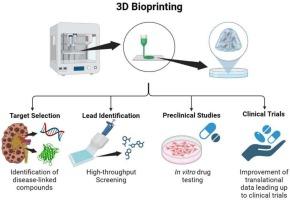当前位置:
X-MOL 学术
›
Adv. Drug Deliver. Rev.
›
论文详情
Our official English website, www.x-mol.net, welcomes your
feedback! (Note: you will need to create a separate account there.)
Recent applications of three-dimensional bioprinting in drug discovery and development
Advanced Drug Delivery Reviews ( IF 15.2 ) Pub Date : 2024-09-19 , DOI: 10.1016/j.addr.2024.115456 Kaixing Yang, Lingxin Wang, Sanjairaj Vijayavenkataraman, Yunong Yuan, Edwin C.K. Tan, Lifeng Kang
Advanced Drug Delivery Reviews ( IF 15.2 ) Pub Date : 2024-09-19 , DOI: 10.1016/j.addr.2024.115456 Kaixing Yang, Lingxin Wang, Sanjairaj Vijayavenkataraman, Yunong Yuan, Edwin C.K. Tan, Lifeng Kang

|
The ability of three-dimensional (3D) bioprinting to fabricate biomimetic organ and disease models has been recognised to be promising for drug discovery and development as 3D bioprinted models can better mimic human physiology compared to two-dimensional (2D) cultures and animal models. This is useful for target selection where disease models can be studied to understand disease pathophysiology and identify disease-linked compounds. Lead identification and preclinical studies also benefit from 3D bioprinting as 3D bioprinted models can be utilised in high-throughput screening (HTS) systems and to produce efficacy and safety data that closely resembles clinical observations. Although no published applications of 3D bioprinting in clinical trials were found, there are two clinical trials planning to evaluate the predictive ability of 3D bioprinted models by comparing human and model responses to the same chemotherapy. Overall, this review provides a comprehensive summary of the latest applications of 3D bioprinting in drug discovery and development.
中文翻译:

三维生物打印在药物发现和开发中的应用进展
三维 (3D) 生物打印制造仿生器官和疾病模型的能力已被公认为在药物发现和开发方面很有前途,因为与二维 (2D) 培养物和动物模型相比,3D 生物打印模型可以更好地模拟人类生理机能。这对于靶标选择非常有用,其中可以研究疾病模型以了解疾病病理生理学并识别与疾病相关的化合物。3D 生物打印也有利于先导化合物鉴定和临床前研究,因为 3D 生物打印模型可用于高通量筛选 (HTS) 系统,并产生与临床观察非常相似的疗效和安全性数据。尽管在临床试验中没有发现 3D 生物打印的已发表应用,但有两项临床试验计划通过比较人类和模型对相同化疗的反应来评估 3D 生物打印模型的预测能力。总体而言,本文全面总结了 3D 生物打印在药物发现和开发中的最新应用。
更新日期:2024-09-19
中文翻译:

三维生物打印在药物发现和开发中的应用进展
三维 (3D) 生物打印制造仿生器官和疾病模型的能力已被公认为在药物发现和开发方面很有前途,因为与二维 (2D) 培养物和动物模型相比,3D 生物打印模型可以更好地模拟人类生理机能。这对于靶标选择非常有用,其中可以研究疾病模型以了解疾病病理生理学并识别与疾病相关的化合物。3D 生物打印也有利于先导化合物鉴定和临床前研究,因为 3D 生物打印模型可用于高通量筛选 (HTS) 系统,并产生与临床观察非常相似的疗效和安全性数据。尽管在临床试验中没有发现 3D 生物打印的已发表应用,但有两项临床试验计划通过比较人类和模型对相同化疗的反应来评估 3D 生物打印模型的预测能力。总体而言,本文全面总结了 3D 生物打印在药物发现和开发中的最新应用。


















































 京公网安备 11010802027423号
京公网安备 11010802027423号